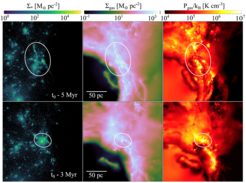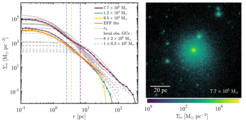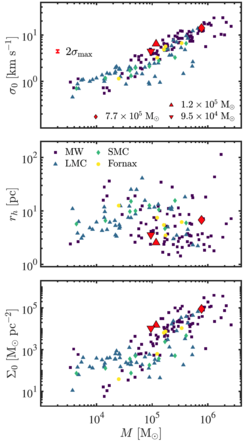Globular cluster formation deciphered

Fig. 1: Stellar distribution (left), gas (middle), and pressure (right) in a dense region of the dwarf starburst at two different times in the simulation ( top: 5 million years, bottom: 3 million years before the final assembly of the cluster). In the highest density and pressure region (white ellipses) stellar proto-clusters are forming and rapidly merging into a massive star cluster with globular cluster properties.
Several hundred globular star clusters orbit the Milky Way galaxy as remnants of an unknown star formation process that had to be common in the early Universe, when these clusters formed, but is rarely observed today. More massive galaxies such as the nearby elliptical M87 have tens of thousands of these clusters, largely resembling those around the Milky Way. These globular clusters all have typical masses of several hundred thousand solar masses and typical radii of several parsecs. It is speculated that the oldest and chemically unenriched globular clusters formed in the early days of the Universe on timescales of only a few million years in merging small galaxies.
Motivated by this scenario, the team has performed the highest resolution simulation so far of a such a merger spanning seven orders of magnitude in time, density and pressure. In addition to low temperature gas cooling and star formation, the simulation accounts for the mass and energy output from ionization and type II supernovae from individual massive stars, and it includes the non-equilibrium chemical evolution of the dense interstellar medium (ISM) exposed to a space- and time-dependent interstellar radiation field.

Fig. 2: Left: Density distribution of the three most massive clusters (colored) in comparison to observed local massive star clusters and globular clusters (grey). Right: Density distribution of the most massive simulated globular cluster.
The simulation has a maximum spatial resolution of 0.1 pc, a stellar and gas mass resolution of four solar masses and the time evolution is resolved down to 10 years. This is the most realistic and highest resolution simulation of such a system with a baryonic mass of 100 million solar masses. During the galaxy merger the gas is compressed by four orders of magnitudes and the system evolves into a phase of extreme star formation (Fig. 1).
In this phase individual star clusters are forming with masses from a few hundred to several ten thousand solar masses following a mass function which is also seen in real dwarf galaxies. In the densest regions of the merger a few star clusters reach almost one million solar masses on very short timescales of only a few million years (Fig 1). Their mass distributions are very similar to observed massive star clusters and globular clusters (Fig. 2). The velocity dispersions, half-mass radii, and central surface densities of the three most massive forming clusters are indistinguishable from massive stellar clusters and globular clusters in the dwarf galaxies Fornax and the Small and Large Magellanic Clouds (SMC and LMC), as well as in the Milky Way (Fig. 3). Their average stellar metallicities are close to the initial value of 0.1 solar, indicating that the clusters have not been significantly enriched by star formation during their short formation times.

Fig. 3: Central velocity dispersion (top), stellar half-mass radius (middle), and central stellar surface density (bottom) of the simulated clusters (large red symbols) in comparison to observed massive star clusters (colored) and globular clusters. The simulated cluster properties agree well with observations.
This study provides a general model for the formation of metal-poor globular clusters in chemically unevolved starbursting environments of low-mass galaxies at high redshifts. This formation scenario is also consistent with observations of young massive clusters in the local Universe, which are thought to be the counterparts of old globular clusters.
Thorsten Naab
for the authors Nathalia Lahen, Thorsten Naab, Peter Johansson, Bruce Elmegreen, Chia-Yu Hu, and Stephanie Walch














